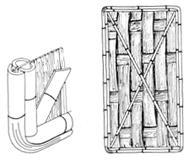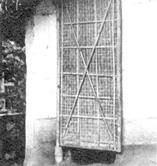Doors and windows
Shutters for doors and windows are also made of
bamboo. These are of three basic types: shutters that slide across the opening, hinged
shutters or pivoted shutters (fig.109).  The
window shutters either slide across the opening or are hinged at the top and swing up to
open. All shutters are normally mat panels framed by bamboo splits with diagonal bamboo
braces. The sliding shutters for both doors and windows are hung from a whole bamboo
member located above the opening and fixed sufficiently away from the wall to permit free
movement. The sliding detail is composed of either a whole bamboo or longitudinal half
fixed to both vertical sides of the panel and extending above the top edge. These
verticals have circular or elliptical holes through which the fixed horizontal member
supports the shutter. The holes are large enough to permit easy sliding. The
window shutters either slide across the opening or are hinged at the top and swing up to
open. All shutters are normally mat panels framed by bamboo splits with diagonal bamboo
braces. The sliding shutters for both doors and windows are hung from a whole bamboo
member located above the opening and fixed sufficiently away from the wall to permit free
movement. The sliding detail is composed of either a whole bamboo or longitudinal half
fixed to both vertical sides of the panel and extending above the top edge. These
verticals have circular or elliptical holes through which the fixed horizontal member
supports the shutter. The holes are large enough to permit easy sliding.
|
 In
the hinged shutter, the hinge used is normally made by binding the shutter either to the
post or a beam, using lengths of split cane or metal wire (fig.110). In the case of
pivoted doors, the pivot detail is a large diameter whole culm length with diaphragm
retained, which receives the whole bamboo member fixed to one side of the shutter. The
vertical member rests inside the supporting member on its diaphragm and the inner diameter
of the supporting member is larger than the vertical member fixed to the edge of the panel
to permit easy rotation. The pivoted door can use the pivot detail both at the top and
bottom of the door. In cases where the detail is only used at the bottom, cane loop hinges
are used along the edge of the door shutter. Hence, such shutters work on a combination of
the pivot and hinge principle, with the pivot detail preventing the shutter from sagging
at the hinges.
In
the hinged shutter, the hinge used is normally made by binding the shutter either to the
post or a beam, using lengths of split cane or metal wire (fig.110). In the case of
pivoted doors, the pivot detail is a large diameter whole culm length with diaphragm
retained, which receives the whole bamboo member fixed to one side of the shutter. The
vertical member rests inside the supporting member on its diaphragm and the inner diameter
of the supporting member is larger than the vertical member fixed to the edge of the panel
to permit easy rotation. The pivoted door can use the pivot detail both at the top and
bottom of the door. In cases where the detail is only used at the bottom, cane loop hinges
are used along the edge of the door shutter. Hence, such shutters work on a combination of
the pivot and hinge principle, with the pivot detail preventing the shutter from sagging
at the hinges.